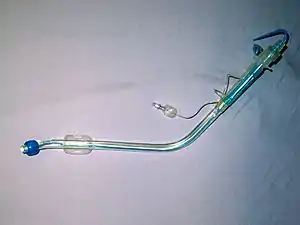Double-lumen endobronchial tube
A double-lumen endotracheal tube (also called double-lumen endobronchial tube or DLT) is a type of endotracheal tube which is used in tracheal intubation during thoracic surgery and other medical conditions to achieve selective, one-sided ventilation of either the right or the left lung.

Indications
There are several conditions that may make one-sided lung ventilation necessary. Absolute indications include separation of the right from the left lung to avoid spillage of blood or pus from an infected or bleeding side to the unaffected side. Relative indications include the collapse of one lung and the selective ventilation of the remaining lung in order to facilitate exposure of the anatomical structures to be operated on in thoracic surgeries, such as the repair of a thoracic aortic aneurysm, pneumonectomy or lobectomy.[1]
Development and description
A DLT is made up of two small-lumen endotracheal tubes of unequal length fixed side by side. The shorter tube ends in the trachea while the longer one is placed in either the left or right bronchus in order to selectively ventilate the left or right lung respectively. The first double-lumen tube used for bronchospirometry and later for one-lung anaesthesia in humans was introduced by Carlens in 1949.[2][3] Modifications to the original Carlens tube have been introduced by White,[4] Robertshaw[5] and others. The most commonly used DLTs today are the Carlens and the Robertshaw tubes.[1] These allow single-lung ventilation while the other lung is collapsed to make Thoracic surgery easier or possible. This may be necessary so as to facilitate the surgeon's view and access to relevant structures within the thoracic cavity. The deflated lung is re-inflated as surgery finishes to check for leakages or other injuries .
These tubes are typically coaxial, with two separate channels and two separate openings. They incorporate an endotracheal lumen which terminates in the trachea and an endobronchial lumen, the distal tip of which is positioned 1–2 cm into the right or left mainstem bronchus.
Proper placement of DLTs requires considerable clinical experience, various techniques for their insertion having been developed.[6][7] And there is a small simulator to help in the training of Carlens tube rotation maneuvers.[8]
Placement has been found to be easier with the aid of fiber optical equipment such as a bronchoscope.[1][9] Currently, flexible fiberoptic bronchoscopy examination is recommended before, during placement, and at the conclusion of the use of DLTs.[10]
Alternatives
Other methods of achieving a one sided lung ventilation are the Univent tube,[11] which has a single tracheal lumen and blocker, and other endobronchial blockers.[12]
The approach to ventilating each lung via a separate ventilator is called the DuoVent approach. This system operates by connecting both ventilators to a master control unit, allowing for synchrony between the two ventilators.
See also
References
- Miller, Ronald.D, Anesthesia, Fifth edition , Section 4: Subspecialty Management, Chapter 48:Anesthesia for Thoracic Surgery Archived May 31, 2013, at the Wayback Machine, published by Churchill Livingstone (2000)
- Carlens E (October 1949). "A new flexible double-lumen catheter for bronchospirometry". J Thorac Surg. 18 (5): 742–746. doi:10.1016/S0096-5588(20)31326-X. PMID 18149050.
- Brodsky J.B, Lemmens H.J.M, "The history of anesthesia for thoracic surgery" Minerva anestesiologica, October 2007 p.519
- White G.M.J, "A New Double lumen tube", Oxford JournalsMedicine BJA Volume 32, Issue 5Pp. 232-234 (1960)
- Robertshaw F.L, "LOW RESISTANCE DOUBLE-LUMEN ENDOBRONCHIAL TUBES" Oxford JournalsMedicine BJA Volume 34, Issue 8Pp. 576-579 (1962)
- Seo, JH; Kwon, TK; Jeon, Y; Hong, DM; Kim, HJ; Bahk, JH (20 June 2013). "Comparison of techniques for double-lumen endobronchial intubation: 90{degrees} or 180{degrees} rotation during advancement through the glottis". British Journal of Anaesthesia. 111 (5): 812–7. doi:10.1093/bja/aet203. PMID 23794671.
- El-Etr AA. Improved technic for insertion of the Carlens catheter. Anesth Analg. 1969 Sep-Oct;48(5):738-40. http://www.anesthesia-analgesia.org/content/48/5/738.full.pdf
- de Menezes Lyra R. Glottis simulator. Anesth Analg. 1999 Jun;88(6):1422-3.
- Purugganan RV, Jackson TA, Heir JS, Wang H, Cata JP (2012). "Video laryngoscopy versus direct laryngoscopy for double-lumen endotracheal tube intubation: a retrospective analysis". J Cardiothorac Vasc Anesth. 26 (5): 845–8. doi:10.1053/j.jvca.2012.01.014. PMID 22361488. S2CID 23311699.
{{cite journal}}: CS1 maint: multiple names: authors list (link) - Campos, JH (February 2010). "Lung isolation techniques for patients with difficult airway". Current Opinion in Anesthesiology. 23 (1): 12–7. doi:10.1097/ACO.0b013e328331e8a7. PMID 19752725. S2CID 29385055.
- J H Campos, D K Reasoner and J R Moyers, "Comparison of a modified double-lumen endotracheal tube with a single-lumen tube with enclosed bronchial blocker" A & A December 1996 vol. 83 no. 6 1268-1272
- Campos, Javier H, "Which device should be considered the best for lung isolation: double-lumen endotracheal tube versus bronchial blockers" Current Opinion in Anesthesiology: February 2007 - Volume 20 - Issue 1 - p 27-31
Further reading
- Brodsky, JB; Lemmens, JM (2003). "Left Double-Lumen Tubes: Clinical Experience With 1,170 Patients" (PDF). Journal of Cardiothoracic and Vascular Anesthesia. 17 (3): 289–98. doi:10.1016/S1053-0770(03)00046-6. PMID 12827573. Archived from the original (PDF) on 2017-03-12. Alt URL